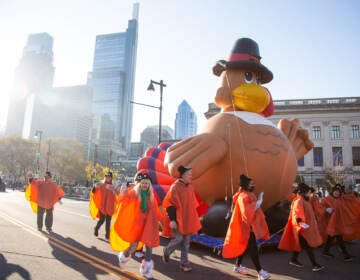Globe Dye Works cast as venue for ambitious sculptural installations
For a few weeks, the old Globe Dye Works factory in the Frankford neighborhood of Philadelphia is hosting industrial-sized sculpture.
Hanging from the wooden rafters of what used to be a room for dying textiles are pieces of boats. They appear to be wreckage, with their hulls broken and half-missing. Actually, they were made entirely of foam by artist Scott Pellnat.
He mechanized them with electric motors. The assemblage of kinetic sculptures throbs and thrusts and spins in herky-jerky patterns.
“I love the jerkiness, because all the ropes that attach them all shake with it. I like that,” said Pellnat of Somerset, N.J. “You can lose yourself in the movement, like dance. But they’re not dancers, they’re boats.”
Pellnat is one of 16 artists with work at Globe Dye Works. Hailing from as far as Idaho, Vancouver, and Israel, each got a room of their own to install a site-specific sculpture.
The title of the show, “Catagenesis,” is a term used in biology and geology to refer to the process of one thing breaking down to become the basis of something else.
The crumbling, cavernous, 125 year-old Globe Dye Works was actively in use until it was sold in 2005. The current owners have been slowly renovating it, in piecemeal fashion, into offices and studio spaces.
The spaces still waiting for renovation — and there are a lot of them — are in rough shape, with failing roofs and damp floors littered with boilers, plumbing, sewing machines, rusted iron, and musty textiles.
“There are pieces of machinery here that nobody knows what they did,” said Philadelphia Sculptors director Leslie Kaufman. “All the practical parts that could be sold were sold. So what is left behind really is of no use to anybody but a scrap dealer, or an artist.”
Carving out a place for sculpture
The Philadelphia Sculptors is a membership organization that gives regional artists opportunities to show their work. Kaufman says sculpture has become a stepchild in the art world, often seen as being too difficult to accommodate.
The show includes a conceptual piece on the roof of the building, where Reece Terris altered the iconic “Globe Dye Works” sign to read “Good Bye Work,” a reference to global capitalism. Pam Bowman and Christine Altman each created pieces referencing the process of manufacturing textile.
Artist Elizabeth Mackie of Frenchtown, N.J., discovered that during the heyday of Globe Dye Works, in the 1930s and ’40s, as many as 200 men and women were employed on the factory floor. When one of the women married (and, more likely than not, quit factory work) her co-workers would pitch in and buy her a farm animal. The tradition appears to be unique to Globe Dye Works’ company culture.
Mackie’s piece, called “The Globe Wedding,” features a giant wedding dress — layered by 400 yards of tulle — onto which is projected images of pigs, ducks, geese, turkeys, and — oddly — pigeons.
“Traditional sculpture is objects on pedestals or objects on the floor. The world has changed so much,” said Kaufman. “There is no definition of sculpture. I was interested in giving artists the opportunity to work outside the white box. This is about as far from a white box as you can find.”
“Catagenesis” at the Globe Dye Works is the most ambitious event the Philadelphia Sculptors have attempted in its 15-year history.
The exhibition runs until Oct. 21, open on weekends only, at 4500 Worth St., Philadelphia.
WHYY is your source for fact-based, in-depth journalism and information. As a nonprofit organization, we rely on financial support from readers like you. Please give today.




